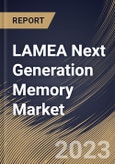Persistent memory is emerging as a compelling use case for next-generation memory technologies. Persistent memory allows data to be retained even in the event of a power loss, which is crucial for applications requiring data integrity and resilience. It finds application in areas like financial services, where data consistency is of utmost importance. The widespread use of next-generation memory solutions is also being driven by the trend toward edge computing, which entails processing data near the source instead of depending only on centralized data centers. Edge computing demands rapid data access and low latency, making these memory solutions increasingly vital for supporting this paradigm shift.
AI, ML, and edge computing are emerging technologies that greatly depend on memory technologies that offer quick access to large amounts of data. These developments are essential to the creation and implementation of innovative services and applications. Next-generation memory technologies have a number of benefits, one of which is that they are not volatile. It implies that even in the absence of power, they maintain their data. This feature helps reduce boot times and is essential for improving data integrity - a vital concern for companies that depend on constant access to critical data.
The Dubai Health Authority (DHA) offers a high-quality healthcare infrastructure in Dubai by creating and implementing medical policies and procedures in public and private hospitals and clinics. Furthermore, the DHA creates a health policy for Dubai that considers future demands, ensures collaborations between private and public health service providers, and authorizes and controls the Dubai Health Sector. This aims to continually uphold quality, patient safety, clinical competence, and rights protection objectives. DHA has also promoted the use of connected devices and modern technologies in the sector, which has increased the requirement for facilities like data centers.
Moreover, according to the International Trade Administration, Brazil has one of the prominent healthcare sectors in Latin America, with a 9.1% GDP share. Thus, because of the rapidly expanding healthcare industry and data center construction in the region, the development of next-generation memory would also be successful.
The Brazil market dominated the LAMEA Next Generation Memory Market, By Country in 2022, and would continue to be a dominant market till 2030; thereby, achieving a market value of $414 million by 2030. The Argentina market is showcasing a CAGR of 20.9% during (2023 - 2030). Additionally, The UAE market would register a CAGR of 20% during (2023 - 2030).
Based on Technology, the market is segmented into Non-volatile (Magneto-resistive Random-access Memory (MRAM), Ferroelectric RAM (FRAM), SRAM, Resistive Random-access Memory (ReRAM), Nano RAM, and Others), and Volatile. Based on Wafer Size, the market is segmented into 300 mm, and 200 mm. Based on Vertical, the market is segmented into Enterprise Storage, Consumer Electronics, BFSI, Telecommunications, Information Technology, Government, Automotive & Transportation, and Others. Based on countries, the market is segmented into Brazil, Argentina, UAE, Saudi Arabia, South Africa, Nigeria, and Rest of LAMEA.
The market research report covers the analysis of key stake holders of the market. Key companies profiled in the report include Samsung Electronics Co. Ltd., Micron Technology, Inc., Fujitsu Limited, Toshiba Corporation, Honeywell International, Inc., Microchip Technology, Inc., Everspin Technologies, Inc., Infineon Technologies AG, Kingston Technology Company, Inc., and Intel Corporation.
Scope of the Study
Market Segments Covered in the Report:
By Technology- Non-volatile
- Magneto-resistive Random-access Memory (MRAM)
- Ferroelectric RAM (FRAM)
- SRAM
- Resistive Random-access Memory (ReRAM)
- Nano RAM
- Others
- Volatile
- 300 mm
- 200 mm
- Enterprise Storage
- Consumer Electronics
- BFSI
- Telecommunications
- Information Technology
- Government
- Automotive & Transportation
- Others
- Brazil
- Argentina
- UAE
- Saudi Arabia
- South Africa
- Nigeria
- Rest of LAMEA
Key Market Players
List of Companies Profiled in the Report:
- Samsung Electronics Co. Ltd.
- Micron Technology, Inc.
- Fujitsu Limited
- Toshiba Corporation
- Honeywell International, Inc.
- Microchip Technology, Inc.
- Everspin Technologies, Inc.
- Infineon Technologies AG
- Kingston Technology Company, Inc.
- Intel Corporation
Unique Offerings
- Exhaustive coverage
- The highest number of Market tables and figures
- Subscription-based model available
- Guaranteed best price
- Assured post sales research support with 10% customization free
Table of Contents
Companies Mentioned
- Samsung Electronics Co. Ltd.
- Micron Technology, Inc.
- Fujitsu Limited
- Toshiba Corporation
- Honeywell International, Inc.
- Microchip Technology, Inc.
- Everspin Technologies, Inc.
- Infineon Technologies AG
- Kingston Technology Company, Inc.
- Intel Corporation
Methodology

LOADING...








